Citroen DS5 HYBRID4 2014 1.G Owner's Manual
Manufacturer: CITROEN, Model Year: 2014, Model line: DS5 HYBRID4, Model: Citroen DS5 HYBRID4 2014 1.GPages: 380, PDF Size: 13.62 MB
Page 241 of 380

239Practical information
DS5-HYBRID_EN_CHAP08_INFO PRATIQUES_ED02-2013
After refitting the battery, the Stop & Start system will only be active after several hours depending on the climatic conditions and the state of charge of the battery (up to about 8 hours).
When your vehicle's battery is discharged, the engine can be started using a slave battery (external or on another vehicle) and jump lead cables.
Starting using another
battery
First check that the slave battery has a nominal voltage of 12 V and a capacity at least equal to that of the discharged battery. Do not try to start the engine by connecting a battery charger. Do not disconnect the (+) terminal when the engine is running.
Remove the plastic cover from the (+) terminal, if your vehicle has one. Connect the red cable to the positive terminal (+) of the flat battery A , then to the positive terminal (+) of the slave battery B . Connect one end of the green or black cable to the negative terminal (-) of the slave battery B (or earth point on the other vehicle). Connect the other end of the green or black cable to the earth point C on the broken down vehicle (or on the engine mounting). Start the engine of the vehicle with the good battery and leave it running for a few minutes.
Operate the starter on the broken down vehicle and let the engine run If the engine does not start straight away, switch off the ignition and wait a few moments before trying again. Wait until the engine returns to idle then disconnect the jump lead cables in the reverse order. Refit the plastic cover to the (+) terminal, if your vehicle has one.
Disconnect the battery from the vehicle. Follow the instructions for use provided by the manufacturer of the charger. Connect the battery starting with the negative terminal (-). Check that the terminals and connectors are clean. If they are covered with sulphate (whitish or greenish deposit), remove them and clean them.
Charging the battery using
a battery charger
Page 242 of 380
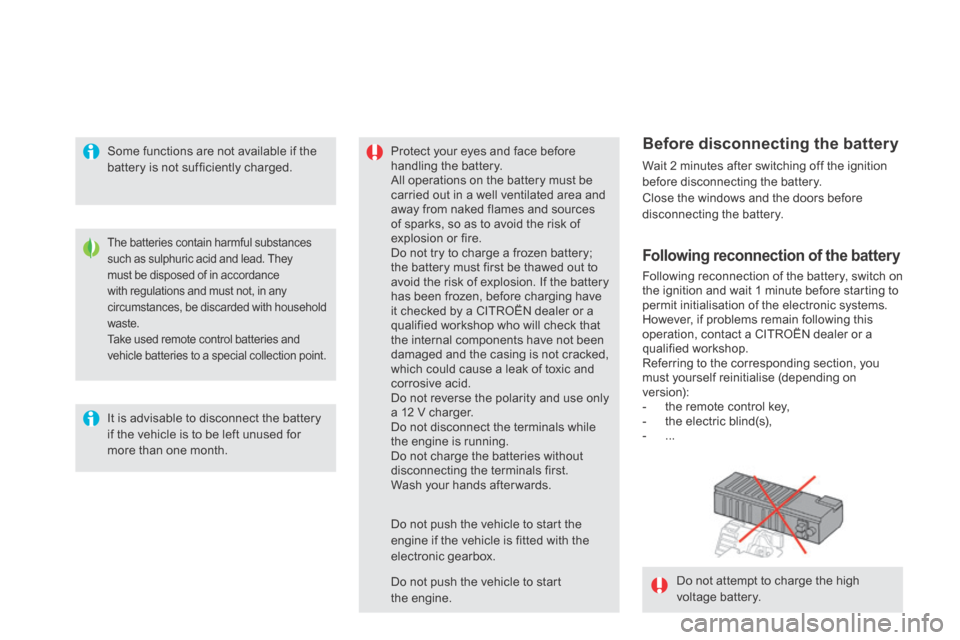
DS5-HYBRID_EN_CHAP08_INFO PRATIQUES_ED02-2013
Do not attempt to charge the high
voltage battery.
The batteries contain harmful substances such as sulphuric acid and lead. They must be disposed of in accordance with regulations and must not, in any circumstances, be discarded with household waste. Take used remote control batteries and vehicle batteries to a special collection point.
It is advisable to disconnect the battery
if the vehicle is to be left unused for more than one month.
Protect your eyes and face before handling the battery. All operations on the battery must be carried out in a well ventilated area and away from naked flames and sources of sparks, so as to avoid the risk of explosion or fire. Do not try to charge a frozen battery; the battery must first be thawed out to avoid the risk of explosion. If the battery has been frozen, before charging have it checked by a CITROËN dealer or a qualified workshop who will check that the internal components have not been damaged and the casing is not cracked, which could cause a leak of toxic and corrosive acid. Do not reverse the polarity and use only a 12 V charger. Do not disconnect the terminals while the engine is running. Do not charge the batteries without disconnecting the terminals first. Wash your hands after wards.
Do not push the vehicle to start the engine if the vehicle is fitted with the electronic gearbox.
Before disconnecting the battery
Wait 2 minutes after switching off the ignition before disconnecting the battery. Close the windows and the doors before disconnecting the battery.
Following reconnection of the battery
Following reconnection of the battery, switch on the ignition and wait 1 minute before starting to permit initialisation of the electronic systems. However, if problems remain following this operation, contact a CITROËN dealer or a qualified workshop. Referring to the corresponding section, you must yourself reinitialise (depending on version): - the remote control key, - the electric blind(s), - ...
Do not push the vehicle to start the engine.
Some functions are not available if the battery is not sufficiently charged.
Page 243 of 380
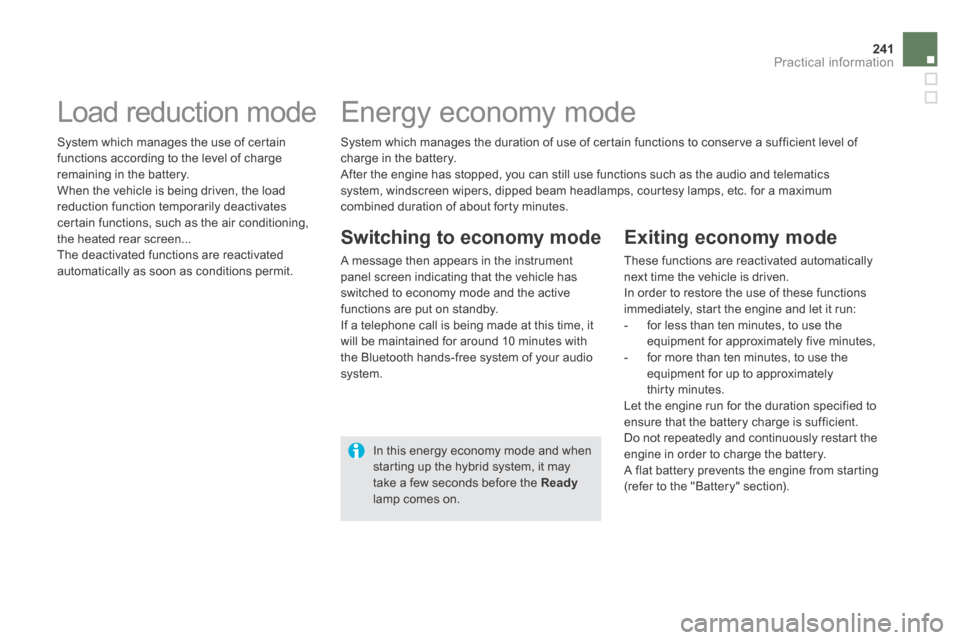
241Practical information
DS5-HYBRID_EN_CHAP08_INFO PRATIQUES_ED02-2013
System which manages the duration of use of certain functions to conserve a sufficient level of charge in the battery. After the engine has stopped, you can still use functions such as the audio and telematics system, windscreen wipers, dipped beam headlamps, courtesy lamps, etc. for a maximum combined duration of about forty minutes.
Energy economy mode
Switching to economy mode
A message then appears in the instrument panel screen indicating that the vehicle has switched to economy mode and the active functions are put on standby. If a telephone call is being made at this time, it
will be maintained for around 10 minutes with the Bluetooth hands-free system of your audio system.
Exiting economy mode
These functions are reactivated automatically next time the vehicle is driven. In order to restore the use of these functions immediately, start the engine and let it run: - for less than ten minutes, to use the equipment for approximately five minutes, - for more than ten minutes, to use the equipment for up to approximately thirty minutes. Let the engine run for the duration specified to ensure that the battery charge is sufficient. Do not repeatedly and continuously restart the engine in order to charge the battery. A flat battery prevents the engine from starting (refer to the "Battery" section).
In this energy economy mode and when starting up the hybrid system, it may take a few seconds before the Readylamp comes on.
Load reduction mode
System which manages the use of certain functions according to the level of charge remaining in the battery. When the vehicle is being driven, the load reduction function temporarily deactivates certain functions, such as the air conditioning, the heated rear screen... The deactivated functions are reactivated automatically as soon as conditions permit.
Page 244 of 380

DS5-HYBRID_EN_CHAP08_INFO PRATIQUES_ED02-2013
Changing a wiper blade
Before removing a front
wiper blade
Removing
Raise the corresponding wiper arm. Unclip the wiper blade and remove it.
Fitting
Put the corresponding new wiper blade in place and clip it. Fold down the wiper arm carefully.
After fitting a front wiper
blade
Switch on the ignition. Operate the wiper stalk again to park the wiper blades.
Within one minute after switching off the ignition, operate the wiper stalk to position the wiper blades vertically on the windscreen.
Page 245 of 380
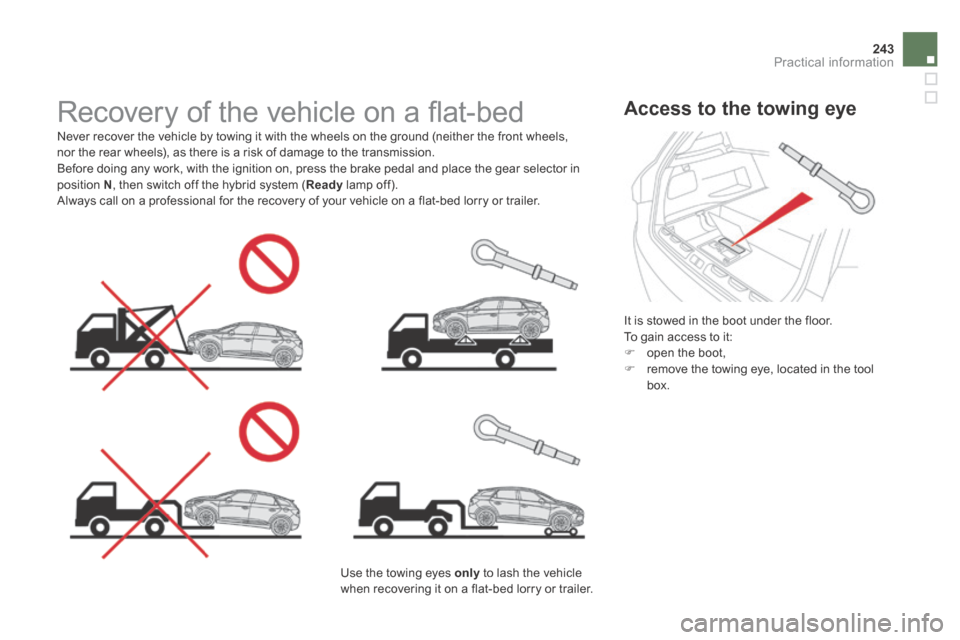
243Practical information
DS5-HYBRID_EN_CHAP08_INFO PRATIQUES_ED02-2013
Access to the towing eye
It is stowed in the boot under the floor. To gain access to it: open the boot, remove the towing eye, located in the tool box.
Recovery of the vehicle on a fl at-bed
Never recover the vehicle by towing it with the wheels on the ground (neither the front wheels, nor the rear wheels), as there is a risk of damage to the transmission. Before doing any work, with the ignition on, press the brake pedal and place the gear selector in position N , then switch off the hybrid system ( Ready lamp off). Always call on a professional for the recovery of your vehicle on a flat-bed lorry or trailer.
Use the towing eyes only to lash the vehicle when recovering it on a flat-bed lorry or trailer.
Page 246 of 380

DS5-HYBRID_EN_CHAP08_INFO PRATIQUES_ED02-2013
Towing a trailer
Towbar suitable for the attachment of a trailer or installation of a bicycle carrier, with additional lighting and signalling.
When not towing a trailer, remove the quickly-detachable tow ball before driving, so as to avoid masking the central rear lamp.
Maximum trailer weight
The towing weight is limited: refer to the "Technical data" section.
Your vehicle is primarily designed for transporting people and luggage, but it may also be used for towing a trailer.
At the front
On the front bumper, unclip the cover by pressing at the bottom to disengage the securing lugs. Screw the towing eye in fully.
At the rear
On the rear bumper, unclip the cover by levering at the left with the point of the towing eye. Screw the towing eye in fully.
Page 247 of 380
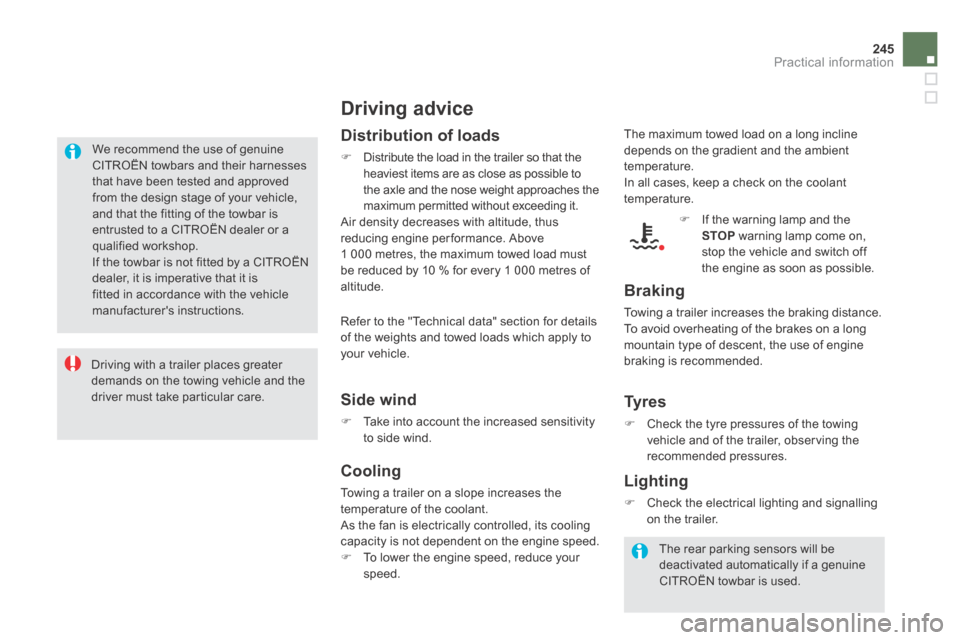
245Practical information
DS5-HYBRID_EN_CHAP08_INFO PRATIQUES_ED02-2013
We recommend the use of genuine CITROËN towbars and their harnesses that have been tested and approved from the design stage of your vehicle, and that the fitting of the towbar is
entrusted to a CITROËN dealer or a qualified workshop. If the towbar is not fitted by a CITROËN dealer, it is imperative that it is fitted in accordance with the vehicle manufacturer's instructions.
Driving advice
Distribution of loads
Distribute the load in the trailer so that the heaviest items are as close as possible to the axle and the nose weight approaches the maximum permitted without exceeding it. Air density decreases with altitude, thus
reducing engine performance. Above 1 000 metres, the maximum towed load must be reduced by 10 % for every 1 000 metres of altitude.
Side wind
Take into account the increased sensitivity to side wind.
Cooling
Towing a trailer on a slope increases the temperature of the coolant. As the fan is electrically controlled, its cooling capacity is not dependent on the engine speed. To lower the engine speed, reduce your speed.
If the warning lamp and the STOP warning lamp come on, stop the vehicle and switch off the engine as soon as possible.
Braking
Towing a trailer increases the braking distance. To avoid overheating of the brakes on a long mountain type of descent, the use of engine braking is recommended.
Ty r e s
Check the tyre pressures of the towing vehicle and of the trailer, observing the recommended pressures.
Lighting
Check the electrical lighting and signalling on the trailer.
The rear parking sensors will be deactivated automatically if a genuine CITROËN towbar is used.
Driving with a trailer places greater demands on the towing vehicle and the driver must take particular care.
The maximum towed load on a long incline depends on the gradient and the ambient temperature. In all cases, keep a check on the coolant temperature.
Refer to the "Technical data" section for details of the weights and towed loads which apply to your vehicle.
Page 248 of 380
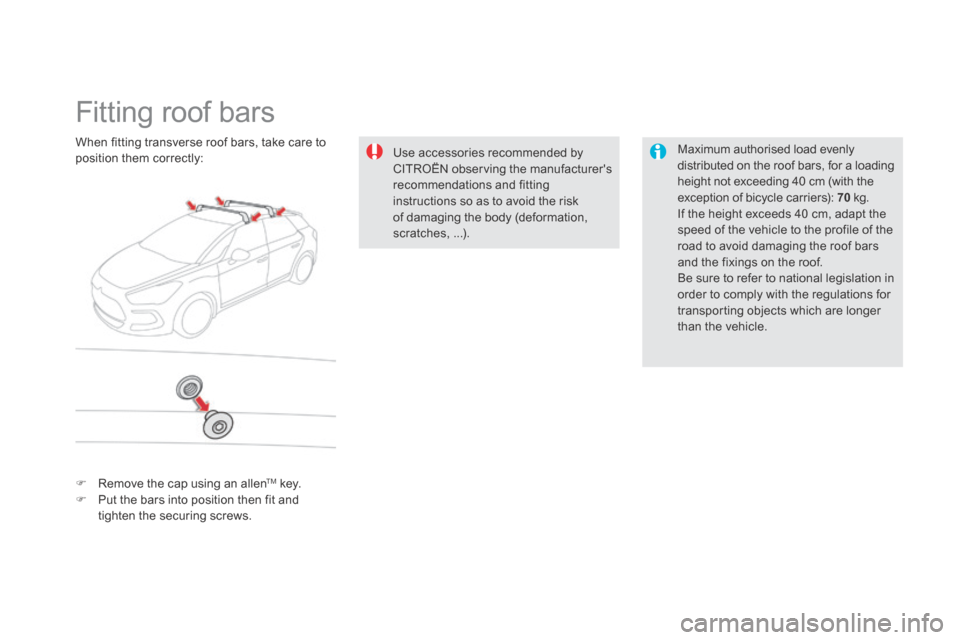
DS5-HYBRID_EN_CHAP08_INFO PRATIQUES_ED02-2013
Fitting roof bars
Maximum authorised load evenly distributed on the roof bars, for a loading height not exceeding 40 cm (with the exception of bicycle carriers): 70 kg. If the height exceeds 40 cm, adapt the
speed of the vehicle to the profile of the road to avoid damaging the roof bars and the fixings on the roof. Be sure to refer to national legislation in order to comply with the regulations for transporting objects which are longer than the vehicle.
When fitting transverse roof bars, take care to position them correctly: Use accessories recommended by CITROËN observing the manufacturer's recommendations and fitting instructions so as to avoid the risk of damaging the body (deformation, scratches, ...).
Remove the cap using an allen TM key. Put the bars into position then fit and tighten the securing screws.
Page 249 of 380
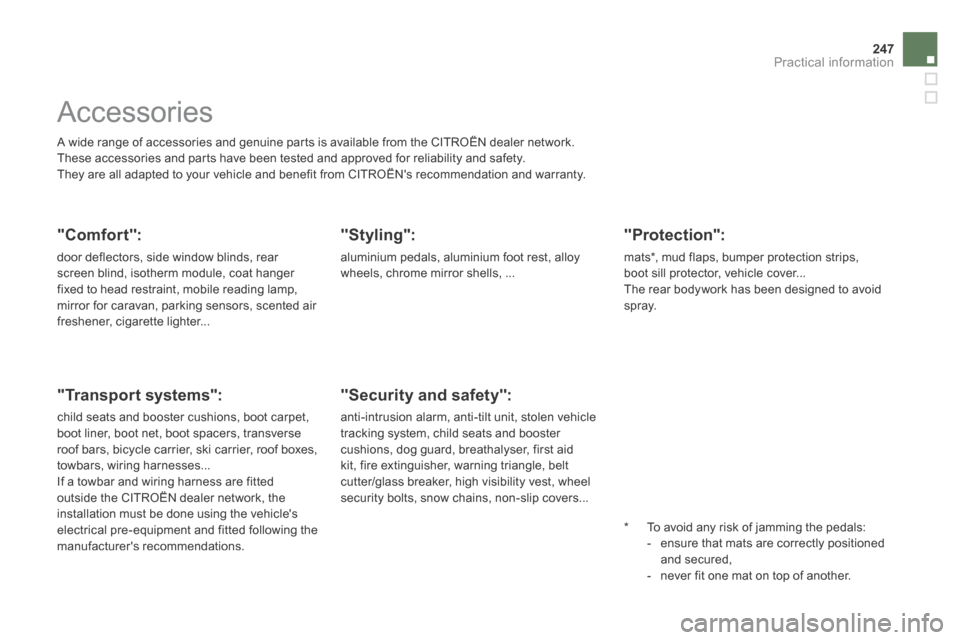
247Practical information
DS5-HYBRID_EN_CHAP08_INFO PRATIQUES_ED02-2013
Accessories
A wide range of accessories and genuine parts is available from the CITROËN dealer network. These accessories and parts have been tested and approved for reliability and safety. They are all adapted to your vehicle and benefit from CITROËN's recommendation and warranty.
"Comfort":
door deflectors, side window blinds, rear screen blind, isotherm module, coat hanger fixed to head restraint, mobile reading lamp, mirror for caravan, parking sensors, scented air freshener, cigarette lighter...
"Transport systems":
child seats and booster cushions, boot carpet, boot liner, boot net, boot spacers, transverse roof bars, bicycle carrier, ski carrier, roof boxes, towbars, wiring harnesses... If a towbar and wiring harness are fitted outside the CITROËN dealer network, the installation must be done using the vehicle's electrical pre-equipment and fitted following the
manufacturer's recommendations.
"Styling":
aluminium pedals, aluminium foot rest, alloy wheels, chrome mirror shells, ...
* To avoid any risk of jamming the pedals: - ensure that mats are correctly positioned and secured, - never fit one mat on top of another.
"Security and safety":
anti-intrusion alarm, anti-tilt unit, stolen vehicle tracking system, child seats and booster cushions, dog guard, breathalyser, first aid kit, fire extinguisher, warning triangle, belt cutter/glass breaker, high visibility vest, wheel security bolts, snow chains, non-slip covers...
"Protection":
mats * , mud flaps, bumper protection strips, boot sill protector, vehicle cover... The rear bodywork has been designed to avoid s p r ay.
Page 250 of 380
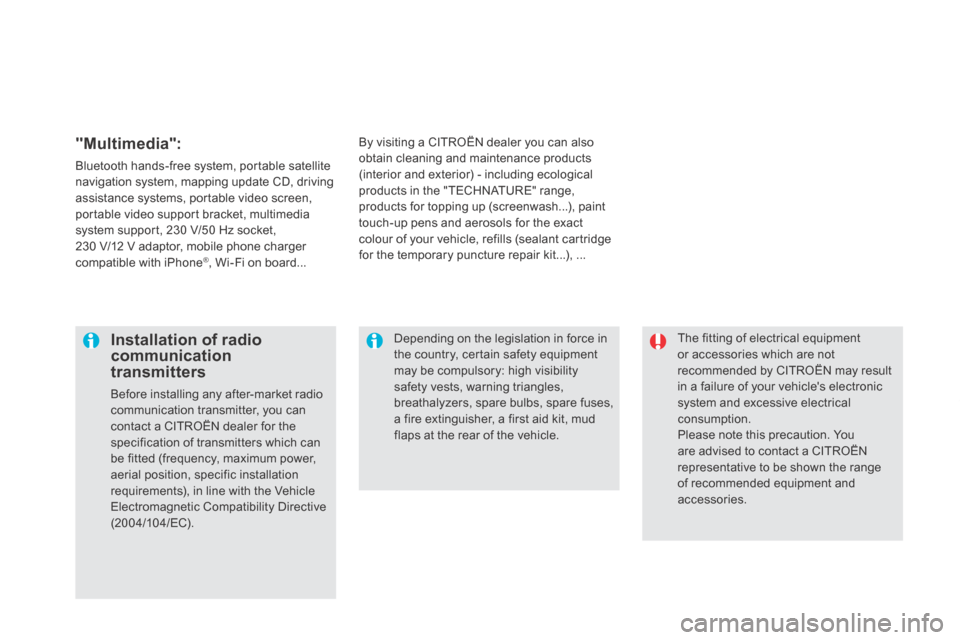
DS5-HYBRID_EN_CHAP08_INFO PRATIQUES_ED02-2013
The fitting of electrical equipment or accessories which are not recommended by CITROËN may result in a failure of your vehicle's electronic system and excessive electrical consumption. Please note this precaution. You are advised to contact a CITROËN representative to be shown the range of recommended equipment and accessories.
Installation of radio communication transmitters
Before installing any after-market radio communication transmitter, you can contact a CITROËN dealer for the specification of transmitters which can be fitted (frequency, maximum power, aerial position, specific installation requirements), in line with the Vehicle Electromagnetic Compatibility Directive (2004/104/EC).
Depending on the legislation in force in the country, certain safety equipment may be compulsory: high visibility safety vests, warning triangles, breathalyzers, spare bulbs, spare fuses, a fire extinguisher, a first aid kit, mud flaps at the rear of the vehicle.
By visiting a CITROËN dealer you can also obtain cleaning and maintenance products (interior and exterior) - including ecological products in the "TECHNATURE" range, products for topping up (screenwash...), paint touch-up pens and aerosols for the exact colour of your vehicle, refills (sealant cartridge for the temporary puncture repair kit...), ...
"Multimedia":
Bluetooth hands-free system, portable satellite navigation system, mapping update CD, driving assistance systems, portable video screen, portable video support bracket, multimedia system support, 230 V/50 Hz socket, 230 V/12 V adaptor, mobile phone charger compatible with iPhone ® , Wi-Fi on board...